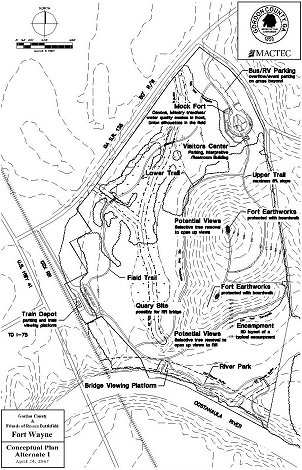Fort Wayne Historic Site Update
 |
| Click the map above to view sections of the Fort Wayne Master Plan. Large files. May take a moment to load on slower connections. |
November 21, 2007 - After an extended effort the Fort Wayne portion of the Resaca Battlefield has been preserved and plans have been secured for its future interpretation. The Friends of the Resaca Battlefield wish to thank the Gordon County Board of Commissioners for all their efforts to secure the Fort Wayne property and for being progressive enough to realize its positive potential for the public.
The Fort Wayne Civil War Historic Site "Master Plan" addresses the important issues of preservation, historic tourism, green space, and river protection, as well as day use recreation such as hiking and walking trails, picnic areas, and interpretive areas. Gordon County cannot have chosen a more experienced firm than MACTEC to put together this site plan.
You can view sections of this master plan here.
Ken Padgett, Friends of the Resaca Battlefield President, states " I know of no other individual site in Gordon County with this extent of such varied and important history involved. It covers pre-Civil War, Civil War, Battle of Resaca, Federal Occupation, and the Reconstruction Era."
A brief history of the site starts in the 1840's with Irish emigrants building the railroad and Oostanaula River Bridge to tie Atlanta to Chattanooga. To this day, the original stone bridge piers quarried on the site still support the present rail bridge. The workers named the hamlet Dublin and, in 1848, returning veterans of the Mexican-American War renamed the village Resaca in honor of their victory at the Battle of Resaca de la Palma, "dry river bed of the palm."
After the near-destruction of the Oostanaula rail bridge during the Great Locomotive Chase on April 12, 1862, Georgia's wartime Governor Joseph Brown ordered the formation of the Georgia State Line Troops to protect the railroads and serve the State within its borders. Georgia Adjutant and Inspector General Henry C. Wayne was placed in command. In 1863, the State Line Troops fortified a section of high hills northeast of the Oostanaula River to guard the rail bridge. The State Line built massive sections of earthen entrenchments, and two large artillery redoubts. The fortification was named in honor of General Wayne.
On May 9th, 1864 a small force of 4,000 Confederate soldiers fired the first shots from Resaca at Fort Wayne, forcing a Federal force of 20,000 to retreat to Snake Creek Gap. The guns of Fort Wayne played a vital role during the Battle of Resaca on May 14th and 15th of 1864.
After the fall of Atlanta, the Confederate Army marched back to Resaca to destroy the rail line now in the control of the Federals. On October 12th, 1864, the Confederate Army decided that the old fort's position was too strong to assault and busied itself with destroying the rail line out of the range of the fort's guns.
On May 2, 1865, under a flag of truce, Confederate General William Wofford met with the Federals from the fort to work out the terms of surrender for the remaining Confederate forces in Georgia. During the rest of the war and until the end of Reconstruction, Federal forces manned Fort Wayne.
During this period, the Federal Commander at the fort recorded many injustices against the Resaca citizens. In closing Padgett states, "This project is a model of joint effort by government and preservationists and the project will have a great economic impact by bringing tourism dollars into Gordon County."
Fund raising efforts to implement the master plan are now being planned by local officials and FORB, Inc.